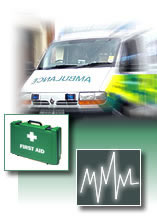


Most minor burns occur at home and can
be dealt with quickly. However if you are in doubt of the severity
of the burn, contact your doctor. If burns are severe, dial 999 for
an ambulance immediately.
The next step is to protect the burn from infection and germs by completely but loosely covering it with a dry clean, light, non-fluffy piece of cloth, a burns sheet (if available) or a piece of clean kitchen cling film. In the case of large or serious burns, the person could be in shock and should be laid down. Their legs should be raised and supported. The persons breathing and pulse rate should be checked every 5 minutes until the ambulance arrives. |
|||||||||||||